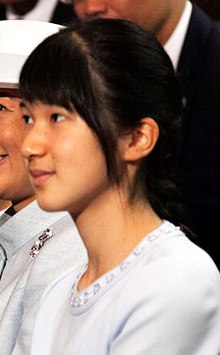Aiko (princess)
Aiko, Princess Toshi ( Japanese 敬 宮 愛 子 , Toshi-no-miya Aiko Naishinnō; born December 1, 2001 in Tokyo ) is a princess who belongs to the Japanese imperial family . She is the daughter of Emperor Naruhito and Empress Masako .
Life
Surname
Deviating from the tradition according to which the emperor chooses the name, the parents suggested the name. They were inspired by the teachings of the Chinese philosopher Mengzi , especially the sentence
"A person who respects the others is respected by the others, and a person who loves the others is loved by the others."
The name is written using the Kanji ideograms of the words "love" and "child" and means "daughter of love". Her imperial title is Princess Toshi (敬 宮 愛 子 内 親王Toshi-no-miya Aiko Naishinnō ), which means "person who respects others".
education
The princess started school on April 3, 2006 in the preschool of the Gakushūin Institute. She attended until March 15, 2008. When she was eight years old, she suspended classes to protect against possible bullying. From the end of April 2010, Aiko attended some lessons again, but only the first three hours of the day. Princess Masako accompanied Aiko to school every day and picked her up, and a member of the court was also in class. During this time, a young unemployed man was convicted of having willingly proposed on a blog that the princess should be murdered, despite assurances not to prosecute him. Aiko finished primary school on March 18, 2014. On April 6, 2014, she entered the girls' secondary school.
On the occasion of her eighth birthday, her interests, which include calligraphy , skipping rope, playing the piano and violin, and writing poetry, became known.
In February 2020, she was accepted by Gakushūin University , where she will study Japanese language and literature.
Public performances
On April 5, 2016, she visited a special exhibition in the Edo Tokyo Museum on the establishment of diplomatic relations between Japan and Italy 150 years ago.
Succession to the throne
The Imperial Household Act of 1947 abolished the Japanese nobility and restricted the imperial family to the descendants of Taishō - Tennō . The rules preclude a woman from assuming the throne . If the rules had been changed, Aiko would currently be at the top of the line of succession.
Her birth sparked a debate in Japan about whether the house law should be changed from agnatic primogeniture to absolute primogeniture, which would enable a firstborn daughter to succeed a younger brother or cousin. Even if there were eight reigning empresses in Japanese history, their successors were always sought among male relatives. Only once followed an empress, Gemmei , her daughter, Gensho . Since her successor was her brother's son, the throne remained in the same agnatic line. That is why conservative scholars regard the reign of women as only a temporary phenomenon and want the traditional male line of succession to be maintained in the 21st century.
On October 25, 2005, a government-appointed commission of experts presented a report in which the change from the rule of succession to the absolute primogeniture was recommended. On January 20, 2006, Prime Minister Junichiro Koizumi spoke about it during his annual address and undertook to submit a bill to parliament . Koizumi had not announced a schedule for the introduction of the new rule, nor did he provide any details about the content. However, he indicated that it should be consistent with the 2005 conclusions.
The proposals to replace the agnatic primogeniture were archived in February 2006 when it was announced that the younger brother of the heir to the throne, Prince Akishino , and his wife were expecting their third child. On September 6, 2006, Princess Kiko gave birth to her son Hisahito , who is currently second in line to the throne, behind his father, the Crown Prince. It was the first male prince birth in Japan in 41 years. On January 3, 2007, Prime Minister Shinzo Abe announced that the amendment to the house law had become obsolete. Therefore, it is still unlikely that the laws of succession will be changed in order for Aiko to become empress.
Web links
Individual evidence
- ↑ Interview: Press Conference by His Imperial Highness The Crown Prince on the Occasion of His Birthday: Question 2. ( Memento from January 4, 2008 in the Internet Archive ) In: kunaicho.go.jp. February 20, 2002, accessed September 3, 2019.
- ↑ Japan's Princess Aiko, 4, starts kindergarten . redOrbit .
- ↑ Princess Aiko finishes kindergarten .
- ^ Giappone: Principessina Aiko vittima di bullismo a scuola . March 5, 2010.
- ↑ Giappone: dopo i bullish, minacce di morte per la principessina Aiko . In: AnimeClick.it . Retrieved August 17, 2018.
- ^ Message: Princess Aiko celebrates 8th birthday. ( Memento of December 3, 2009 in the Internet Archive ) In: The Mainichi Daily News. December 3, 2009, accessed September 3, 2019.
- ^ Princess Aiko to enter Gakushuin University in Tokyo in April . In: The Asahi Shimbun , February 21, 2020. Retrieved February 26, 2020.
- ^ Japan-Italy diplomatic relations 150th anniversary special exhibition .
- ^ A b Life in the Cloudy Imperial Fishbowl The Japan Times , March 27, 2007.
- ↑ a b Edoardo Quiriconi: La futura Famiglia Imperiale giapponese. (No longer available online.) In: Dissensi & Discordanze. January 30, 2015, archived from the original on August 18, 2018 ; accessed on September 3, 2019 (English).
- ^ Richard Ponsonby-Fane (1959).
| personal data | |
|---|---|
| SURNAME | Aiko |
| ALTERNATIVE NAMES | Naishinnō, Toshi-no-miya Aiko (full name); 敬 宮 愛 子 (ja-hani) |
| BRIEF DESCRIPTION | japanese princess |
| DATE OF BIRTH | December 1, 2001 |
| PLACE OF BIRTH | Tokyo |
